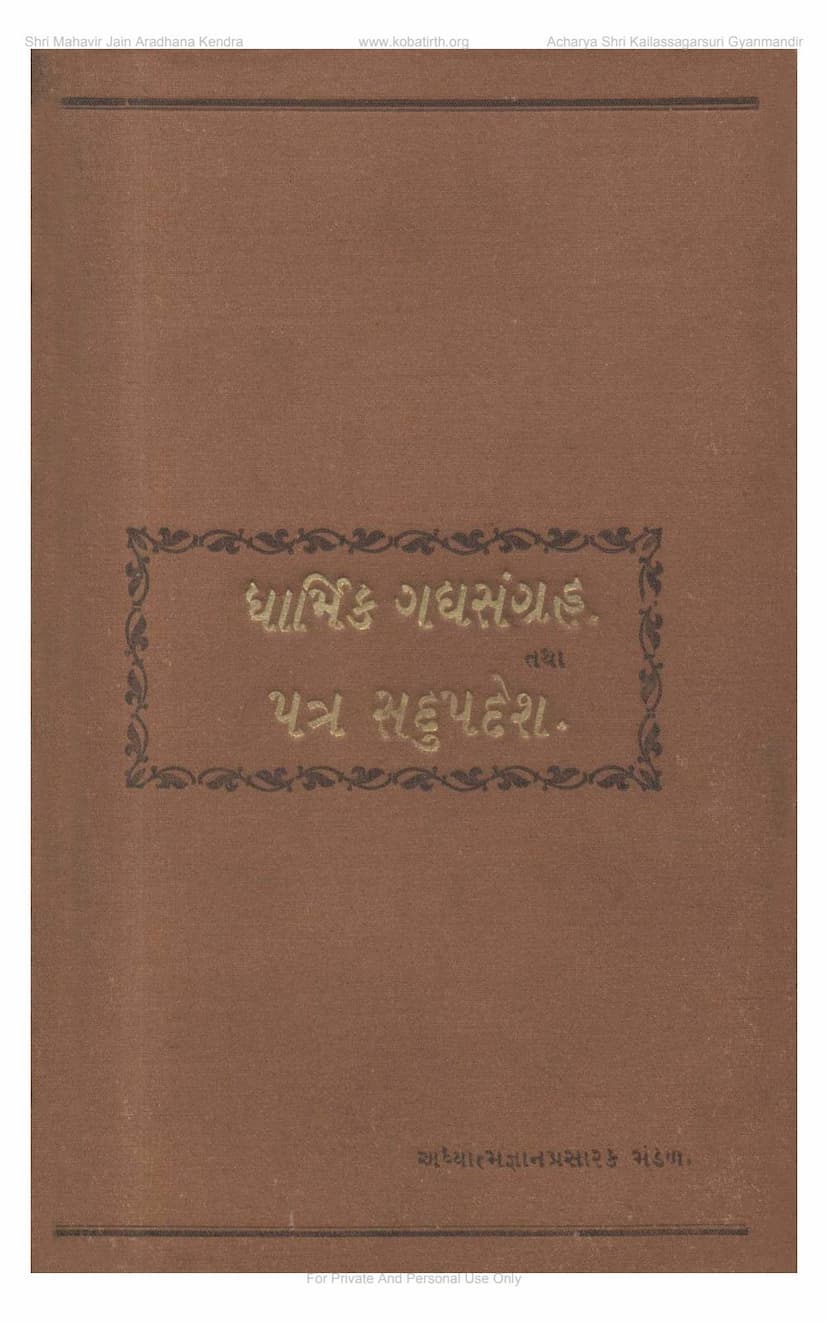Dharmaik Gadya Sangraha Tatha Patrasadupadesh
Added to library: September 1, 2025

Summary
This is a comprehensive summary of the Jain text "Dharmaik Gadya Sangraha Tatha Patrasadupadesh" by Buddhisagar, based on the provided text fragments.
Book Title: Dharmaik Gadya Sangraha Tatha Patrasadupadesh Author: Buddhisagar Publisher: Adhyatma Gyan Prasarak Mandal
Overall Summary:
"Dharmaik Gadya Sangraha Tatha Patrasadupadesh" is a collection of religious prose and correspondence compiled by Acharya Shri Buddhisagarji Surishwar. The book aims to provide spiritual guidance and philosophical insights rooted in Jainism. It encompasses a wide range of topics, including the nature of the soul, the path to liberation, ethical conduct, the importance of spiritual practices, and commentary on various aspects of religious life. The text emphasizes introspection, detachment, the pursuit of knowledge, and the cultivation of virtues like non-violence, truthfulness, and equanimity. It draws heavily from Jain philosophy and the teachings of spiritual masters.
Key Themes and Concepts:
- The Nature of the Soul (Atma): The text frequently delves into the soul's true nature, describing it as eternal, pure, and inherently divine (Atma is Parmatma). It stresses the importance of realizing this divine essence within oneself through introspection and spiritual practices. The soul's journey through various life forms and its ultimate goal of liberation (Moksha) are discussed.
- Spiritual Path and Practices: The book outlines various spiritual paths and practices, including meditation (Dhyana), self-inquiry (Atman-vichar), detachment (Vairagya), ethical conduct (Achar), and the importance of a Guru's guidance. It stresses the need for sincere devotion and understanding the underlying principles rather than mere outward ritual.
- Ethical Living and Virtues: A significant portion of the text is dedicated to ethical principles and virtues essential for a spiritual life. These include:
- Ahimsa (Non-violence): The paramount importance of non-violence in thought, word, and deed is highlighted.
- Truthfulness (Satya): Speaking the truth and living by it is emphasized.
- Equanimity (Samata): Maintaining a balanced state of mind in all circumstances is crucial.
- Detachment (Vairagya): The necessity of renouncing worldly desires and attachments for spiritual progress.
- Self-Control (Sanyam): Controlling the senses and the mind is presented as a vital practice.
- Right Knowledge, Right Faith, Right Conduct (Samyak Darshan, Gyan, Charitra): These are identified as the core components of the spiritual path.
- The Role of the Guru: The text underscores the indispensable role of a Guru in guiding the disciple towards spiritual realization. A true Guru's teachings, grace, and example are considered vital for self-discovery and liberation.
- Understanding Truth through Multiple Perspectives (Anekantavada): While not explicitly detailed in the fragments, the emphasis on understanding the multifaceted nature of reality and the importance of respecting diverse viewpoints (implied by the discussion of different religious beliefs and the need for tolerance) points towards the Jain principle of Anekantavada.
- The Importance of Introspection and Self-Realization: The text repeatedly urges readers to turn inward, explore their true selves, and realize the divine potential within. This self-discovery is presented as the ultimate goal, leading to true happiness and liberation.
- Critique of Superficiality: The author often contrasts superficial adherence to rituals or external appearances with the deeper internal transformation that leads to true spiritual growth. The book advocates for sincerity and inner realization over mere outward show.
- Social and Ethical Responsibility: The text also touches upon social harmony, ethical conduct in worldly affairs, and the importance of contributing to the well-being of society. It encourages compassion and service to all beings.
- The Nature of Karma: The concept of karma and its influence on one's destiny is implicitly present, emphasizing that actions (karma) have consequences and that righteous conduct leads to positive outcomes.
- The Power of Thought: The text highlights the profound impact of thoughts on one's inner state and external circumstances, encouraging the cultivation of positive and virtuous thoughts.
- The Value of Effort and Perseverance: The importance of continuous effort, perseverance, and dedication in the spiritual journey is repeatedly emphasized.
Structure and Style:
The book is presented as a collection of prose and letters, suggesting a direct and instructive style. The language is philosophical and spiritual, aiming to guide the reader towards self-improvement and spiritual enlightenment. The daily reflections (Vichare) from 1968 (Vikram Samvat) offer a glimpse into the author's personal spiritual insights and observations throughout the year, covering a wide range of practical and philosophical advice.
Target Audience and Purpose:
The primary audience for this book would be spiritual seekers, individuals interested in Jain philosophy, and those looking for guidance on living a virtuous and meaningful life. The purpose is to disseminate spiritual knowledge, encourage introspection, and provide practical advice for spiritual progress within the framework of Jainism.
Overall Impact:
"Dharmaik Gadya Sangraha Tatha Patrasadupadesh" serves as a spiritual compendium, offering timeless wisdom from Acharya Buddhisagarji. It aims to elevate the reader's understanding of Jain principles and inspire them to live a life guided by righteousness, self-awareness, and compassion. The collection of prose and letters makes the teachings accessible and relatable, addressing the spiritual needs of individuals in their daily lives.